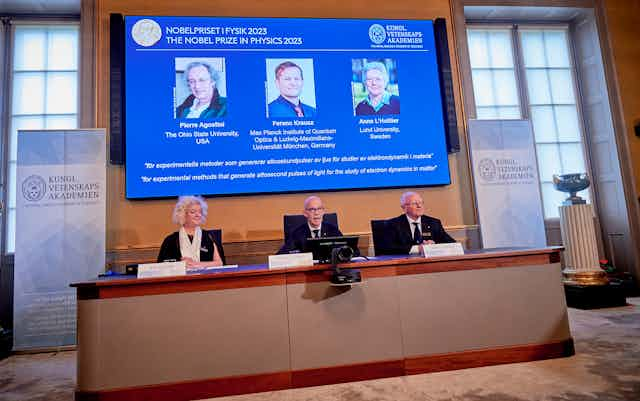I am serving my ninth and final year in the Nobel Committee for Physics, which is an absolutely fascinating job – albeit hard. The best bit is hearing the reactions of the shocked laureates when they receive some of the biggest news of their lives over the phone.
Sometimes, I also give presentations about how Nobel laureates are selected. This can be in front of participants in a Nobel symposium, or in front of a high school class. And I have noticed that, while the topic tends to generate great interest, the process is poorly understood.
Read more: Nobel prize in physics awarded for work unveiling the secrets of electrons
Explaining how the laureates are selected isn’t entirely straightforward, however – there are strict rules of secrecy. I have to rely on material taken from the official website of the Nobel prize on the one hand, and case studies that are older than 50 years and therefore no longer secret on the other.
The Nobel Committee consists of about six to eight members appointed by the Royal Swedish Academy of Sciences. The work to select a prize is divided into three parts. The first and very important part is the nominations. The committee sends out about 3,000 letters to researchers all over the world each September and October asking for nominations, with a deadline of January 31 the following year.
The list of nominees is regulated so that certain people are always consulted, including former Nobel laureates, professors of physics in the Nordic countries, and members of the Royal Swedish Academy of Sciences.
Then there is quite a large other group of people who are invited to make nominations but only for a few years at a time, so this part of the process is rotated regularly. Finally, many universities are asked to consult some faculty for their nomination, and once again the universities are rotated.
The second part involves expert reports. Based on the nominations, the committee identifies certain areas of physics where discoveries or inventions have occurred at a level that may make them eligible for an award.
The committee then solicits confidential reports from experts in these chosen areas, who are asked whether they regard these discoveries or inventions of sufficient importance to motivate a Nobel prize. If they do, they are also asked to identify the individuals they consider have made the most important contributions.
The final part is the work done by the committee. At the beginning of June, the committee meets and puts together a shortlist of the most interesting prize candidates. The discussions in the committee are always open, sharp, frank and sometimes emotional, but never hostile.

In the early 1920s, for example, there was enormous pressure to award Albert Einstein. But some members of the committee were sceptical about the theory of relativity. The compromise was to award Einstein for the explanation of a phenomenon called the photoelectric effect instead, which is exactly the effect this year’s laureates have investigated in great detail.
Amazingly, while the other successful theory of modern physics, quantum mechanics, has been richly awarded with Nobel prizes (1932/33, 1945, 1954, 2022), it took until 2020 for the theory of relativity to be awarded explicitly.
Final stages
During the summer, each committee member works on their own to prepare certain sections of the final prize report. During a retreat in August, the committee meets and finalises this report, with a recommendation to the Royal Swedish Academy of Sciences. There are actually several meetings between committee members during the summer months, but contact by email and telephone is strictly forbidden.
The report, including a suggestion for a maximum of three laureates and a citation, is then sent to the academy. In September, the suggestion is discussed among the physics members of the academy. During a second September meeting, this group takes a vote on whether it supports the suggestion from the committee.
In October, on the same day the prize is announced, the academy meets again to make a final decision, which cannot be appealed. Once the decision has been taken, the laureates are contacted by telephone. Finally, the decision is announced at a press conference that is broadcast live on Swedish public TV and on the academy’s homepage.
The day after the announcement, a few of the committee members start helping with the poster that will be freely available to the public in connection with the Nobel lectures in December.
By now, the work on next year’s Nobel prize in Physics has already started – even before this year’s nominations were known. There are always expert reports that are discussed and solicited. The work never stops!

